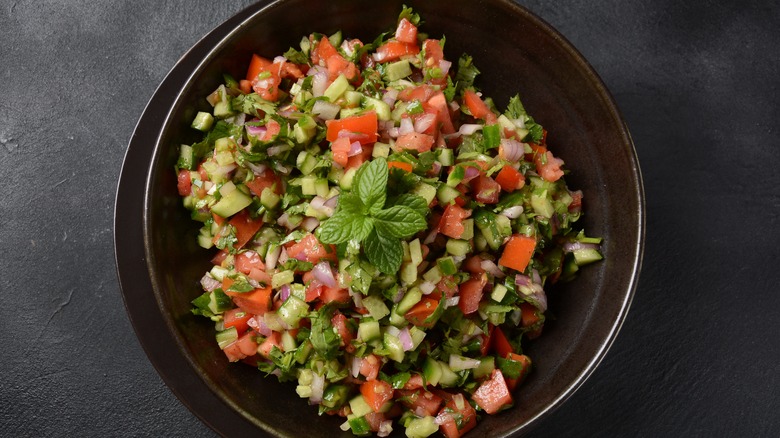Sabich Is The Eggplant Breakfast Sandwich You Need To Try
A sabich sandwich, a creation of Iraqi Jews, is a perfectly balanced breakfast all wrapped up in pita bread. This show-stopper of a sandwich is packed with contrastingly complementary flavors and textures to make an addictively delicious meal. Originally eaten in Israel for breakfast on Saturday mornings, it has become an anytime, any-place dish, whether you find it in a restaurant, at a street food stall, or you assemble it yourself at home.
Made by filling a pita with a large variety of different ingredients, including fried eggplant, hard-boiled egg, hummus, Israeli pickles, tahini, Israeli salad — consisting of chopped tomato, onion, cucumber, and peppers — and a spicy mango chutney called amba, sabich is the Israeli breakfast sandwich that is sure to satisfy. A perfect representation of the Mediterranean diet, to which many Israelis adhere, sabich is a largely plant-based meal, chock full of healthy fats. Many Americans have made the switch to the increasingly popular Mediterranean diet in recent years, due to its being touted as a heart-healthy diet that promotes longevity — and yet, the magic of the sabich sandwich still remains unknown to many.
A little more about the ingredients
To the untrained eye, sabich may sound rather similar to a falafel sandwich, another quintessential Israeli street food that consists of patties made of fried and spiced chickpeas, Israeli salad, and tahini in a pita. While sabich shares a few of the same ingredients, there are some tasty differences that set it apart. A sabich sandwich is a sort of mix-and-match affair. All of the ingredients are prepared in advance and you can choose what you like to stuff your pita with. The eggplant is a defining feature, but beyond that, you can customize it as you like. You can choose to add some extra zing with the amba, which is a pickle made of unripened green mango. Or you can add some heat with zhug, a hot green sauce from Yemen that combines chiles, herbs, and spices.
When the soft, fried eggplant, which acts as the base for sabich, is combined with the snap of the super sour Israeli pickles and the crunch of the fresh Israeli salad, it creates an unmatched sort of textural perfection. The creamy nuttiness of the tahini when combined with the powerful flavor of tangy and sweet amba creates a perfect balance of flavors. You can opt to add fresh pickled cabbage, cucumber, chopped onion, boiled eggs, or cooked potatoes. As all of the ingredients can be prepared in advance, Sabich is the traditional breakfast eaten on the morning of Shabbat, the Jewish day of rest.
How sabich is made
Sabich is easy to construct once you have all your ingredients ready, though a little messy to eat once you combine them all. While the pickles, amba, and tahini are ingredients that you can purchase in a store, and which most Israeli home cooks already have on hand, the fried eggplant, hard-boiled eggs, and Israeli salad require a bit of preparation.
For many Americans, the term "fried eggplant" may conjure visions of the deep-fried breadcrumb-crusted variety commonly used in eggplant parmesan. In the case of sabich, however, the eggplant is sliced thin and gently pan-fried in olive oil until tender and dark brown. The Israeli salad, on the other hand, requires no cooking but a great deal of chopping. Once the tomatoes, persian cucumbers, and peppers have been seeded, they are all finely diced and combined with minced onion, olive oil, salt, pepper, parsley, and a touch of lemon juice.
Sabich is made by smearing a fresh, fluffy pita with tahini, hummus, and amba, and stuffing it full of fried eggplant, Israeli salad, plus any of the other traditional fillings you would like. Because sabich is served cold, many Israelis prepare the fried eggplant and hard-boiled eggs on Friday prior to shabbat and store them in the fridge for later use, as cooking is prohibited on the day of rest.
Where sabich was, and where it is now
While sabich is considered a traditional Israeli food, it was brought to Israel by Iraqi Jews who, during the '40s and '50s, were forced to flee their home country after Nazi antisemitic propaganda threatened their safety. Many of those refugees settled in the city of Ramat Gan, and by the 1960s, the city's streets were lined with street food vendors selling tasty Iraqi fare to locals. One of those Iraqi street food vendors, a man named Sabich, is rumored to be the creator of the beloved dish. However, the origins are still somewhat hazy, with some suggesting that the name is born from the Arabic word sabah, which means morning, and others believing the name is an amalgamation of the Hebrew words salat, baytzim, and chatizilim, which translates to salad, eggplant, and egg, respectively.
Today, sabich is one of Israel's premiere street foods, with vendors selling variations of the sandwich on street corners in every major city. Whether you prefer your sabich vegan style or deep-fried and smothered in cheese, there's a sabich out there for you somewhere. In the U.S., Taim, a Mediterranean chain restaurant famous for its bowls, salads, and pitas, carries sabich, and you can probably find it in many Middle Eastern restaurants. If you're interested in whipping up your own, however, ingredients like Israeli pickles and amba can be found online or at your local Middle Eastern market or international grocery store.



